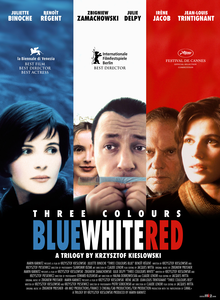The Three Colours: Red is a 1994 French-Swiss romantic mystery film co-written, produced, and directed by Polish filmmaker Krzysztof Kieślowski. As Krzysztof Kieślowski’s Three Colours: Red, the conclusion to the filmmaker’s Three Colours trilogy begins we try to elucidate the nuances of the film. By stating the Three Colours Red explained, at the very onset we witness the sight of a person tapping numbers on a telephone keypad. This series of three conceptually interlocking movies – is his career’s last work. In fact, before he died following heart surgery in 1996 –it was by far Kieslowski’s most significant international hit. It completed as near a perfect cycle of films as late Western cinema has seen, and his writing is impeccable. It may not sound like the most riveting concept, but it certainly turns out to be the perfect precursor to the visual manifestation of the movie’s core theme.

The trilogy shifts gear from high tragedy to low comedy to intense drama in a world of happenstance and coincidence. The movies are shot through with moments of bizarre black comedy, anxiety, and cynicism about Europe itself. Kieślowski’s fascination with inexplicably connected human beings is also exemplified by how Red concerns itself with two seemingly random people.
Decoding The Connection with Colours
As in the previous two films, a single color dominates. Numerous objects in the film are bright red, including the huge advertising banner featuring Valentine’s facial profile. Several images recur throughout the film. Characters are often juxtaposed on different physical levels. The films are Three Colours: Blue (1993), Three Colours: White (1994), and Three Colours: Red (1994). Notionally color-schemed in the manner of the French flag. And structured around the classic themes of the French Republic: liberty, equality, and fraternity. The complexity makes Three Colours: Red such a fascinating contemplative exercise. The entire movie is conscious of the fact that being connected with others doesn’t automatically result in pleasant dynamics nor does it prevent you from feeling painful emotions like heartbreak. But it’s still a necessary part of being alive.
what do colours mean… (Three Colours red explained)

If the colour (bright) red is set to stand for both danger and the possibility of passion when all else has withered, the confrontation between Valentine and the judge is also the isotopic center of the film. The White was suffused with a sense of play and the Blue a cool meditation on awful and bottomless loss. The real themes of the trilogy are more disparate, more chaotic, less high-minded, and far more interesting. In Red, the subtext is all. Not just through the insistent use of color codes but the interlocking, barely glimpsed way in which all the characters are linked either in the filmic present or the imaginary possible futures that Kieslowski sketches.
This film aptly depicts subjects such as the Philosophy of Law and the manner in which man acts in society. It demonstrates also the relationship between the law, ethics, and socially acceptable behavior and how not all of them coincide, particularly in the reflections by Judge Kern and some symbols related to Auguste. Blue, White, and Red is an astonishingly daring piece of narrative rule-breaking. However, that makes absolute emotional sense in light of Kieslowski’s obsessions with chance, luck, and destiny.
In conclusion, Krzysztof Kieślowski not only made a great end to the trilogy with the film Red, but he also explored the varying themes around the different ways of connecting with other souls consciously or unconsciously.



